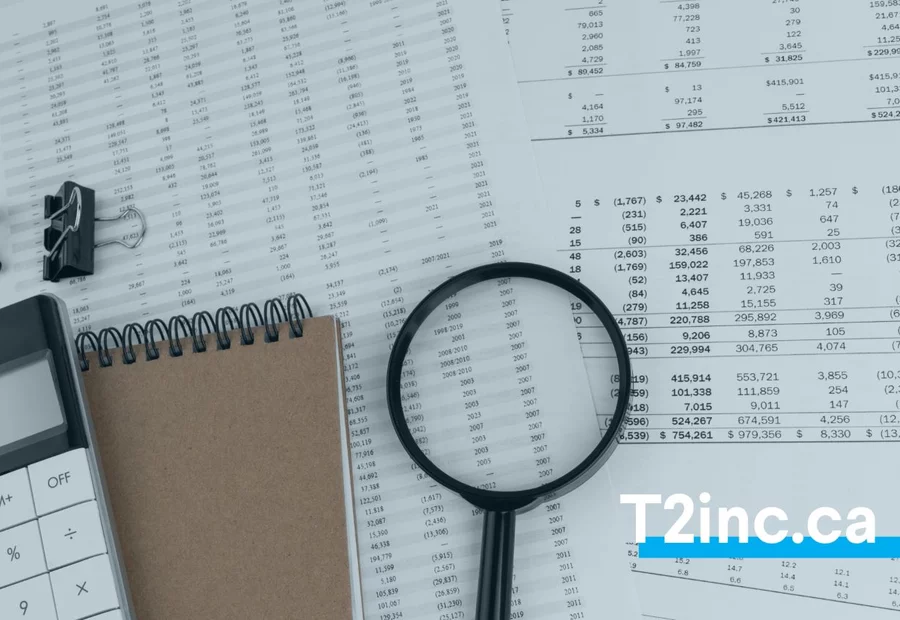Understanding financial statements for a corporation in Canada

Running a business involves much more than selling products or services. It requires strong financial management to track profitability, manage cash flow, and comply with tax rules. This is where financial statements provide essential insights. They offer a clear snapshot of your company’s financial position and ensure compliance with accounting standards and reporting rules.
But what exactly are financial statements, and how do they impact your business decisions? In this guide, we break down the three main types of financial statements, how to prepare financial statements in accordance with accounting requirements, and how to analyze them for better financial management. Read on to ensure your corporation stays financially strong!
What is the meaning of financial statements? Definition
Financial statements are formal records that summarize a company's financial health over a specific period. They report revenues, expenses, assets, liabilities, and net income, helping business owners, investors, and lenders assess financial stability and profitability.
For incorporated businesses, financial statements are required for filing corporate taxes with the Canada Revenue Agency (CRA) and Revenu Québec. Beyond tax compliance, they are essential for securing financing, evaluating business performance, and planning future growth.
Companies may choose to generate quarterly or year-end statements, allowing them to track trends and compare financial performance over multiple periods.
When do you need your financial statements?
Here are some of the key situations where you require financial statements:
- Filing corporate taxes: These documents serve as the foundation for calculating your tax liability and justifying your income and expenses, ensuring compliance with IFRS and tax rules.
- Obtaining financing: Lenders and investors require financial statements before approving loans or investment deals.
- Monitor your company's profitability: They allow you to see if your business is profitable and adjust your strategy.
- Buying or selling a business: If you are selling your company or acquiring another, financial statements are critical for assessing value.
Most business owners prepare their financial statements annually, but some opt for quarterly or monthly reporting to better monitor performance and make proactive financial decisions.
What are the three main types of financial statements?
Financial statements provide a structured way of assessing a company's financial health. Each document serves a different purpose and helps business owners, investors and lenders understand different aspects of a company's performance.
1. The Balance Sheet: a snapshot of the financial situation
The balance sheet provides a financial snapshot of your business at a given moment. It summarizes what your company owns (assets), what it owes (liabilities), and the actual equity that remains after settling debts.
In other words, it answers the essential question: Is my business financially stable?
Here's how it's structured:
- Assets: Cash in bank, equipment, and unpaid customer invoices (accounts receivable).
- Liabilities: Outstanding loans, unpaid vendor bills, and tax obligations.
- Equity and retained earnings: The net worth of your company after deducting liabilities from assets.
Lenders and investors rely on the balance sheet to assess whether your business is financially sound before approving financing. A company with more assets than liabilities is seen as stable, while high debt levels can raise red flags and limit funding options.
2. income statement: analyzing revenues and expenses
The income statement, also known as the profit and loss statement, measures the profitability of your business over a given period of time (monthly, quarterly, or annually). It shows how much money you've made and what you've spent.
It answers a key question: Is my business making money, or am I operating at a loss?
This document is essential for analyzing :
- Revenues: The money your company earns from selling products or services.
- Expenses: The costs of running your business, including salaries, rent, equipment, and advertising.
- Net Profit: The difference between revenue and expenses, indicating whether your company is making or losing money.
The profit and loss statement allows you to evaluate your financial performance and identify areas for improvement. If your profit margin is low, it may indicate pricing or cost management issues. If expenses are rising quickly, you may need to optimize spending to maintain profitability.
3. cash flow statement: tracking cash flow
By definition, the cash flow statement tracks your company's cash inflows and outflows over a period of time. Unlike the balance sheet, which captures a static financial position, the cash flow statement monitors how money moves in and out of your business over a given period.
It helps answer a critical question: Does my business have enough cash to cover day-to-day expenses?
Cash flow is divided into three categories:
- Operating cash flow: Money generated from daily business activities (e.g., sales, payments from clients).
- Investing cash flow: Cash used for purchasing or selling assets such as equipment or property.
- Financing cash flow: Loan proceeds, debt repayments, and stock issuances.
A business can appear profitable on paper but still struggle with cash shortages. By closely monitoring cash flow, you can anticipate shortfalls and take action before running into liquidity problems.
How do you prepare financial statements for a corporation?
Producing financial statements is more than just adding up numbers—it’s a structured process designed to ensure financial transparency, tax compliance, and informed financial decisions. These reports are essential for monitoring your company’s financial position and ensuring compliance with accounting standards and financial reporting rules.
To ensure accuracy and compliance with Canadian accounting standards, you must prepare financial statements with precision. The process involves three main steps: collecting and organizing your financial information, making necessary accounting adjustments in accordance with reporting rules, and finally, generating your financial statement reports using accounting software or an accountant.
1. Collect and organize your financial information
Before you prepare financial statements, it’s essential to gather all financial information that accurately reflects your company's core business activities. Keeping organized financial records throughout the year helps ensure compliance with tax rules, reduces errors, and simplifies financial reporting at year-end.
Here are the main types of information to collect:
- Bank statements and invoices: to track all transactions made by the business.
Accounts Receivable and Accounts Payable: to track payments received and payables.
- Tax filings (GST/QST, corporation tax): to ensure compliance with tax obligations.
Properly organizing these financial activities will save you time during fiscal year-end, minimize reporting errors, and help ensure that your financial statements are prepared accurately and efficiently.
2. Make accounting adjustments in compliance with standards
Once all financial activities are recorded, certain accounting adjustments must be made to ensure that financial statements give a precise view of your company’s financial health and earnings potential. These adjustments align reports with accounting rules and international financial reporting standards (IFRS), ensuring compliance with tax regulations and proper financial transparency.
- Depreciation of assets: Equipment and durable goods depreciate over time. Instead of recording their cost all at once, it is spread over several years.
- Allowance for doubtful accounts: If some customers may never pay their bills, you need to anticipate and account for that loss.
- Tax adjustments: Certain expenses are tax deductible, but must be properly reported to optimize your taxes.
These adjustments allow for more accurate financial statements that meet accounting and tax requirements.
3: Generate financial statements using accounting software
Once all the data is collected and reconciled, it's time to prepare your financial statements. Several accounting tools and software are available to automate the process and limit errors.
Here are the top solutions for small businesses:
- QuickBooks, Sage 50, Xero: Accounting software with advanced features to automate financial management.
- Excel: A more basic option, but one that requires rigorous manual follow-up.
- T2inc.ca: professional assistance to prepare Canadian-compliant financial statements and simplify your tax filing.
Using accounting software or working with a bookkeeper ensures that your financial statements are used effectively for business decisions, tax compliance, and financial planning. These tools also help with statement of changes, keeping track of dividends, and ensuring accuracy in your annual report.
Financial statement analysis: How do I read a financial statement?
Preparing financial statements is one thing, but knowing how to interpret them is just as important. Whether you review them yourself or rely on your corporate accountant, understanding these documents allows you to read financial statements effectively, make better business decisions, and identify financial risks before they escalate.
A well-prepared balance sheet and income statement provide insights into solvency, while the statement of cash flow shows how cash moves within the company. Investors and shareholders closely examine these reports, especially audited financial statements, to assess profitability and financial health.
To extract meaningful insights, you should focus on three critical areas: profitability, financial health, and business trends over time.
1. Evaluate your company's profitability and financial performance
Profitability is one of the most important indicators for any business owner. It shows whether your company is generating enough revenue to sustain operations and grow.
Two ratios are particularly useful:
Profit margin: This compares your net profit to your total revenue, showing how efficiently your business turns sales into profit. A higher margin suggests strong financial health, while a low margin may indicate issues with pricing, cost control, or operational efficiency.
- Profitability ratios (ROI, ROE): These ratios measure the return on investment (ROI) and the return on equity (ROE), helping assess how efficiently your company generates profits relative to its investments.
If profitability metrics are low, consider adjusting pricing strategies, reducing unnecessary expenses, or diversifying revenue streams to improve financial performance.
2. Measure the financial health of your business
A business can be profitable on paper but still struggle with financial stability. Ensuring your company is on solid financial footing means closely monitoring key indicators of liquidity and debt levels.
Here are two things to look for:
The debt-to-equity ratio: This metric compares your company's debt to its total assets. Excessive debt can limit your ability to invest and increase financial risk.
- Liquidity: This measures whether your business has enough available cash to cover short-term expenses like payroll and supplier payments. Poor liquidity can lead to operational difficulties, even if your business appears profitable overall.
If your debt levels are high, consider refinancing loans or negotiating better payment terms with creditors to reduce financial pressure.
3. Compare with prior years
Financial analysis shouldn’t be limited to a single period. Comparing financial statements from previous years helps identify patterns, strengths, and potential warning signs.
Here's what to look for:
Sales growth trends – Consistent growth suggests a strong business model, while stagnation or decline may signal the need for new strategies.
Expense and profitability fluctuations: If costs are rising faster than revenues, it may be time to reassess expenses and look for cost-saving opportunities.
- Strategic financial decisions: Tracking financial trends allows you to anticipate cash flow gaps, plan future investments, and adjust budgets proactively.
Regular analysis gives you a clear, proactive view of your company's financial situation, so you can react quickly and adjust your decisions to ensure your company's growth and longevity.
Call on the experts at T2inc.ca for your financial statements
Financial statements are far more than just a tax requirement—they are essential for financial planning, securing funding, and making informed business decisions. By understanding their role and ensuring accuracy, you can maintain a clear financial vision, anticipate fiscal year obligations, and support sustainable growth.
However, preparing different financial statements requires expertise and time. Properly structured reports on financial performance, including the cash flow statement, the statement of comprehensive income, and the balance sheet, provide critical insights into a company's operating expenses and earned and spent revenue.
If you don’t have an in-house accountant, T2inc.ca offers specialized support through a network of trusted accounting partners. Our experts will ensure that your financial statements are complete and accurate before you file your T2 corporate tax return and/or your CO-17 provincial tax return.
Contact our experts
Have a question? Need help? Fill out our online form to get help from our experts.
Contact usNeed more help?
Contact us by filling out our form
Are you interested in our services, but would like more information before taking the plunge? Contact us today and one of our tax accountants will be in touch to help you.
At T2inc.ca, we're committed to helping business owners manage their company's tax affairs so they can grow their business.




